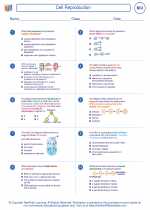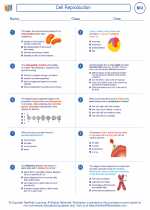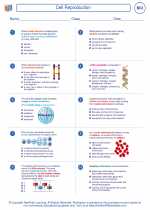Cell Reproduction
Cell reproduction, also known as cell division, is the process by which a parent cell divides into two or more daughter cells. This process is essential for growth, development, and repair of multicellular organisms, as well as for the reproduction of single-celled organisms. There are two main types of cell division: mitosis and meiosis.
Mitosis
Mitosis is the process of cell division that results in the production of two daughter cells that are genetically identical to the parent cell. It is a fundamental process for growth, development, and tissue repair in multicellular organisms. Mitosis is divided into several stages: prophase, metaphase, anaphase, and telophase. During these stages, the genetic material of the cell is replicated and then evenly distributed to the daughter cells.
Meiosis
Meiosis is a special type of cell division that occurs only in the cells that give rise to gametes (sperm and egg cells). The process consists of two successive divisions, resulting in four daughter cells, each with half the number of chromosomes as the parent cell. This reduction in chromosome number is essential for sexual reproduction and the production of genetically diverse offspring.
Study Guide
When studying cell reproduction, it's important to understand the following key concepts:
- Cell Cycle: The series of events that take place in a cell leading to its division and duplication of its DNA to produce two daughter cells.
- Mitosis: The stages of mitosis (prophase, metaphase, anaphase, telophase) and the events that occur during each stage.
- Meiosis: The differences between mitosis and meiosis, the stages of meiosis (meiosis I and meiosis II), and the significance of genetic variation resulting from meiosis.
- Regulation of Cell Division: The role of checkpoints and regulatory proteins in the cell cycle, and how disruptions in cell cycle regulation can lead to diseases such as cancer.
- Significance of Cell Reproduction: The importance of cell reproduction in growth, development, and repair of organisms, as well as its role in sexual reproduction and genetic diversity.
It's also helpful to review diagrams and animations of cell division processes to visualize the key events and understand the spatial and temporal changes that occur within the cell.
Remember to practice applying your knowledge through sample questions and problems related to cell reproduction, and seek clarification on any concepts that may be unclear.
By mastering the concepts and processes of cell reproduction, you'll gain a deeper understanding of how organisms grow, develop, and reproduce, as well as the fundamental mechanisms that underlie these biological processes.
.◂Biology Worksheets and Study Guides High School. Cell Reproduction

 Worksheet/Answer key
Worksheet/Answer key
 Worksheet/Answer key
Worksheet/Answer key
 Worksheet/Answer key
Worksheet/Answer key
